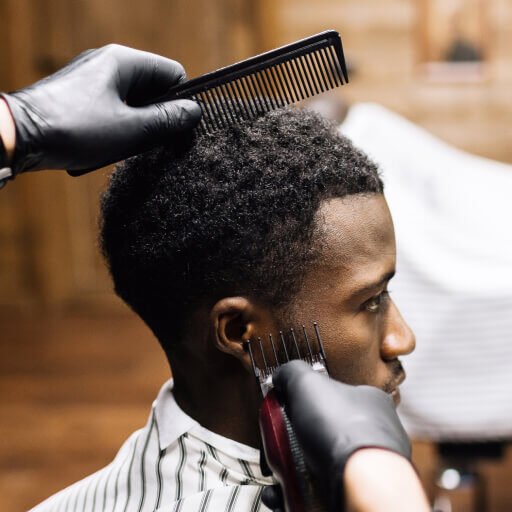The concept of “mobile haircut service” represents a dynamic and growing segment of the beauty and grooming industry. It’s about bringing the expertise and convenience of a professional hairstylist directly to the client’s preferred location, whether that’s their home, office, hotel, or even a special event venue. This model prioritizes the client’s schedule and comfort, transforming a routine grooming task into a luxurious and efficient experience.
The Evolution of Personal Grooming: From Salon to On-Demand
For generations, the salon or barbershop was the undisputed domain for getting a haircut. These establishments offered a social hub, a place to catch up on local gossip, and a chance to escape daily routines. However, modern life, characterized by increasing demands on time and a desire for personalized experiences, has spurred a shift. The rise of the “gig economy” and on-demand services across various sectors – from food delivery to fitness training – has naturally extended to personal care.
Mobile haircut services are a direct response to this evolution. They cater to a diverse clientele who find traditional salon visits challenging, inconvenient, or simply less appealing. The core philosophy is simple: instead of the client coming to the service, the service comes to the client, providing unparalleled flexibility and comfort.
The Mechanics of a Mobile Haircut Service
A mobile haircut service operates on a streamlined, client-centric model. While variations exist, the general workflow is as follows:
- Booking and Scheduling:
- Online Platforms: Most modern mobile haircut services leverage technology. This often involves user-friendly websites or dedicated mobile apps where clients can view available services, browse stylist portfolios, check real-time availability, and book appointments with just a few clicks.
- Phone/WhatsApp: For those who prefer a more direct approach, phone calls or messaging apps like WhatsApp are also common booking channels.
- Detailed Information: Clients typically provide details such as their location, desired service, hair type, and any specific preferences or requirements. This allows the stylist to prepare adequately.
- Stylist Preparation and Travel:
- Equipped for Excellence: Mobile stylists are essentially self-contained mini-salons. They travel with a comprehensive kit of professional tools and products, including high-quality shears, clippers, combs, brushes, blow dryers, flat irons, curling irons, hair products (shampoos, conditioners, styling aids), capes, towels, and often even portable mirrors and protective floor coverings. All tools are meticulously sanitized before and after each appointment.
- Logistics: The stylist plans their route to ensure punctuality, factoring in traffic conditions and travel time between appointments.
- On-Site Service Delivery:
- Setup: Upon arrival, the stylist sets up a designated area, often in a well-lit space in the client’s home or office. Protective coverings are laid down to ensure cleanliness.
- Consultation: A personalized consultation is a cornerstone of the mobile service. The stylist discusses the client’s desired look, current hair condition, lifestyle, and facial features to recommend the most flattering and suitable cut. This one-on-one attention is often more focused than in a busy salon.
- The Haircut: The actual haircut is performed with the same precision and skill as in a traditional salon. Stylists are trained to work efficiently and effectively in various home environments.
- Additional Services: Depending on the client’s request, services might extend to hair washes (some stylists carry portable wash basins, or clients can pre-wash their hair), blow-dries, styling, beard trims, coloring, or even specialized treatments.
- Finishing Touches: The stylist ensures the client is satisfied with the final look, offers styling tips, and tidies up the workspace, removing all hair clippings.
- Payment and Feedback:
- Convenient Transactions: Payments are typically processed digitally through the booking app, credit card readers, or sometimes cash, right after the service is completed.
- Customer Satisfaction: Clients are often encouraged to provide feedback or reviews, which helps maintain service quality and builds the stylist’s reputation.
The Unrivaled Benefits of Mobile Haircut Services
The growing popularity of mobile haircut services stems from a multitude of compelling advantages they offer to a diverse clientele:
- Ultimate Convenience & Time-Saving: This is the primary driver. Clients eliminate travel time, parking hassles, and waiting room delays. A haircut can be scheduled during a lunch break, after work, or on a weekend without disrupting other plans. This reclaimed time is invaluable in today’s demanding world.
- Comfort and Privacy: There’s no place more comfortable or private than one’s own home. Clients can relax in familiar surroundings, wear what they choose, listen to their own music, or even attend to other tasks while getting their hair done. This eliminates the potential anxiety or social pressure of a public salon.
- Personalized Attention: Mobile services inherently offer a one-on-one experience. The stylist’s entire focus is on that single client, leading to more in-depth consultations, tailored advice, and a more precise execution of the desired style. This fosters a stronger client-stylist relationship.
- Accessibility for All: Mobile haircuts are a game-changer for individuals with mobility limitations, the elderly, those recovering from illness, or people with sensory sensitivities who may find traditional salon environments overwhelming. It ensures that professional grooming is accessible to everyone.
- Family-Friendly Solutions: For busy parents, coordinating salon visits for the entire family can be a logistical nightmare. Mobile services allow children and adults to get their haircuts consecutively in the comfort of their home, saving immense time and stress.
- Flexibility in Scheduling: Mobile stylists often offer a wider range of appointment times, including early mornings, late evenings, and weekends, catering to diverse client schedules.
- Discretion and Exclusivity: For high-profile individuals, celebrities, or anyone preferring anonymity, mobile services provide a discreet and exclusive grooming experience away from the public eye.
- On-Location Services for Special Events: Mobile stylists are invaluable for weddings, photoshoots, corporate events, or other occasions where on-site hair styling is crucial.
- Reduced Stress and Anxiety: The absence of a busy, noisy salon environment can significantly reduce stress for clients, leading to a more relaxing and enjoyable experience.
- Hygiene and Cleanliness: Reputable mobile services prioritize strict hygiene protocols, ensuring all tools are sterilized and the workspace is meticulously cleaned before and after each appointment, which can be reassuring for clients concerned about shared spaces.
The Business Model and Market Trends
The global mobile barber shop market is experiencing significant growth. Reports indicate a robust CAGR (Compound Annual Growth Rate), with projections showing substantial market value increases over the next decade. This growth is driven by:
- Increasing Demand for Convenience: As highlighted, this remains the dominant factor.
- Urbanization and Disposable Income: Growing urban populations with higher disposable incomes are more willing to pay for premium, convenient services.
- Gig Economy Proliferation: The mobile model aligns perfectly with the gig economy, offering stylists flexibility and greater earning potential.
- Technological Advancements: Easy-to-use booking apps, online payment systems, and social media for marketing have made it simpler for mobile services to operate and connect with clients.
- Focus on Personalized Luxury: Consumers are increasingly seeking tailored experiences that cater to their individual needs and preferences.
- Eco-Friendly Practices: Some mobile services are adopting sustainable practices, appealing to environmentally conscious consumers.
- Diversification of Services: Mobile stylists are expanding their offerings beyond just haircuts to include beard grooming, coloring, treatments, and even combined wellness services.
Types of Mobile Haircut Businesses:
- Client’s Home-Based: The most common model, where stylists travel to individual clients.
- Combined Model: Traditional salons offering both in-salon and mobile services to expand their reach.
- Completely Mobile Salons: Larger operations that utilize specially equipped vans or trailers as self-contained salons, offering a full range of services on wheels.
Pricing Strategies: Pricing for mobile haircut services typically factors in:
- Travel time and distance: To cover fuel and time spent commuting.
- Overhead costs: Equipment maintenance, products, insurance.
- Stylist’s experience and skill level.
- Market rates: Competitive pricing relative to local salons and other mobile services.
- Service complexity: More intricate cuts or additional services command higher prices.
- Value of convenience: The premium clients are willing to pay for the at-home experience.
Marketing Mobile Haircut Services: Successful mobile haircut services employ a blend of digital and traditional marketing strategies:
- Strong Online Presence: Professional websites, easy-to-use booking apps, and active social media profiles (especially visual platforms like Instagram showcasing before-and-after photos).
- Local SEO: Optimizing Google My Business listings and using location-specific keywords (e.g., “mobile hairdresser near me”).
- Word-of-Mouth and Referrals: Encouraging satisfied clients to spread the word is powerful.
- Partnerships: Collaborating with hotels, corporate offices, event planners, or care facilities.
- Online Reviews: Actively soliciting and managing positive client reviews on various platforms.
Challenges and Considerations for Mobile Haircut Services
Despite the numerous advantages, mobile haircut services also face specific challenges:
- Logistics and Travel: Managing travel time, traffic, and parking can be complex, especially in dense urban areas.
- Inconsistent Workload: As independent entities, mobile stylists may experience fluctuations in demand, impacting income stability.
- Operational Costs: Fuel, vehicle maintenance, insurance, and the continuous replenishment of supplies can be significant.
- Regulatory Compliance: Navigating different local regulations, licensing, and permits can be challenging, particularly if operating across multiple jurisdictions.
- Space Adaptability: Stylists must be adept at working in various client environments, which may not always be ideal in terms of lighting, space, or access to water.
- Client No-Shows/Cancellations: These can be more disruptive for a mobile stylist who has traveled to a location.
- Building Trust: Establishing a rapport with new clients in their private space requires strong professionalism and interpersonal skills.
- Internet Connectivity: Reliance on consistent internet for booking and payment systems can be an issue in remote areas or if encountering technical glitches.
- Safety and Security: While rare, mobile stylists, particularly those working alone, must consider personal safety when visiting unfamiliar locations.
The Future is Mobile
The mobile haircut service model is a testament to how businesses are adapting to modern consumer demands for convenience, personalization, and efficiency. It empowers stylists with flexibility and autonomy while offering clients an unparalleled level of comfort and bespoke service. As urbanization continues and people’s lives become increasingly packed, the demand for high-quality, on-demand services will only grow. The mobile haircut service is not just a trend; it’s a fundamental shift in the beauty industry, poised to become an indispensable part of urban living for individuals seeking professional grooming without the traditional constraints. Sources








